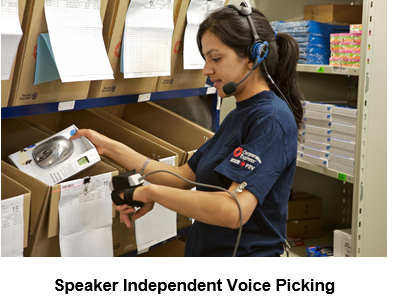Holste Says... |
 |
| Based on what we saw at the show, it now can be said that the currently available robotic technology to “see” and grab individual items and put them in a carton or tote accurately at high picking rates has for the most part been solved. |
 |
What do you say? |
 |
| Click here to send us your comments |
|
|
|
Based on what we saw at the show, it now can be said that the currently available robotic technology to “see” and grab individual items and put them in a carton or tote accurately at high picking rates has for the most part been solved. One current example of this technology in action can be seen at: www.iamrobotics.com
However, while robotic pickers are well on their way to replacing humans, there are still concerns around what the total system design will be, what will the replenishment and takeaway systems look like, how much do you need to spend, and what is the actual ROI from the investment, etc.
As was noted on our Day 2 video, there are a couple of key issues:
- Every system has down time - should you/can you have a manual (humans) back up in case the automated picking system fails? This is a tougher question than it might seem.
- Companies investing in these systems will have to staff or source technologists that can keep these robots running on both the hardware and software fronts. They don't have these people today.
.
The good news is that for shippers not quite ready for robotic picking solutions, there are several proven practical mechanized piece picking technologies that can be added to incrementally improve performance.
.
Pick-to-Light and Speaker Independent Voice Picking are proven “hands-free” picking technologies supported by WMS. With pick-to-light order pickers are directed to the required pick location by flashing lights along the shelves that also display the number of units or cases that need to be picked. With voice picking, the order picker is directed by computer voice to the proper location and once there is told how many units or cases to pick.
As a general rule, lights are best in medium to high volume operations and more dense picking areas like case flow racks. Voice may be a better choice for high volume picking from pallet locations and/or slow moving SKUs that are spread out. For some operations adopting a combination of both technologies will provide the best ROI.
 The most common benefit of hands-free order picking is higher productivity, i.e., the order picker never has to put down (or holster) an RF device (scan gun) to either pick or open cartons. In a voice system the order picker listens to the voice directive while moving to the next location instead of stopping to read the RF device. Industry providers report 30% to 75% reduction in labor with 99.9% order picking accuracy. The most common benefit of hands-free order picking is higher productivity, i.e., the order picker never has to put down (or holster) an RF device (scan gun) to either pick or open cartons. In a voice system the order picker listens to the voice directive while moving to the next location instead of stopping to read the RF device. Industry providers report 30% to 75% reduction in labor with 99.9% order picking accuracy.
However, in some operations an RF combination provides the ability to quickly and accurately capture detailed item information, such as a production batch or serial numbers, more quickly by scanning the items barcode.
In recent years multi-modal technologies have emerged as an answer to improving picker productivity with integrated wearable RF devices. While traditional RF devices are limited to one function, an integrated multi-modal solution allows a picker to seamlessly choose between voice, bar code scanning and manual input without having to switch from one software application to another. When equipped with a hands-free 2D camera, item SKU and lot barcode scan verification is fully integrated into the picking process.
Final Thoughts
As it relates to highly automated picking solutions, it is very important to recognize that there will most likely be a somewhat high level of risk from system faults and/or equipment breakdowns that can shutdown the entire picking operation. Also, it may not be possible to simply bring in more people to keep the operation running. So, to insure that customer orders are shipped on schedule ever day, it would be a good idea to have a well conceived backup plan in place that can be quickly implemented.
.
Any reaction to this Expert Insight column? Send below.
Your Comments/Feedback
|